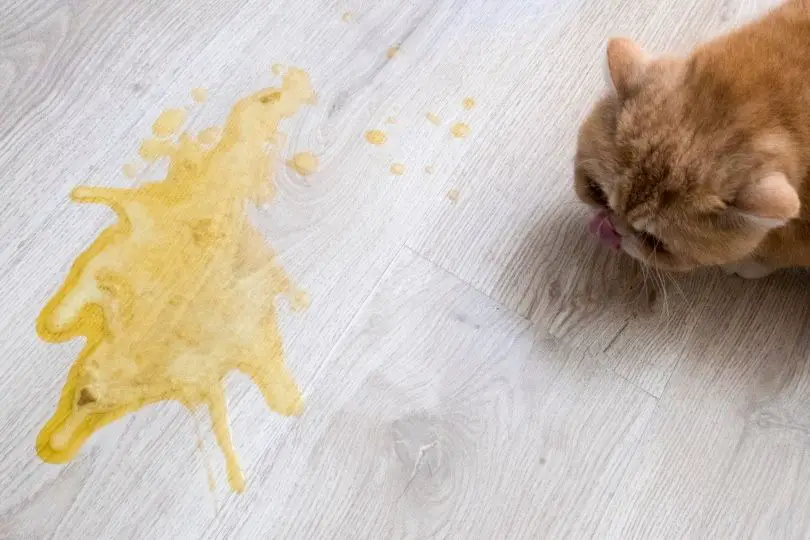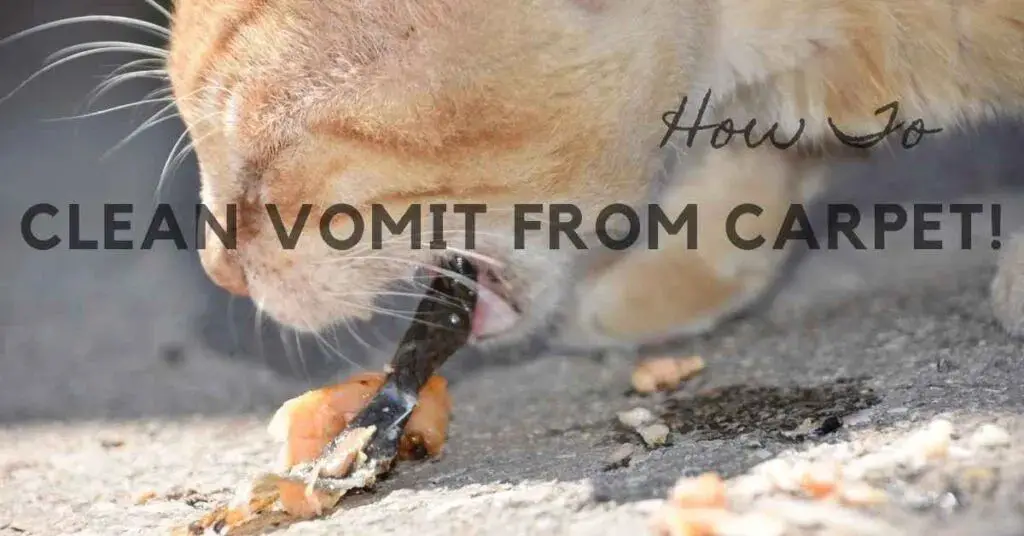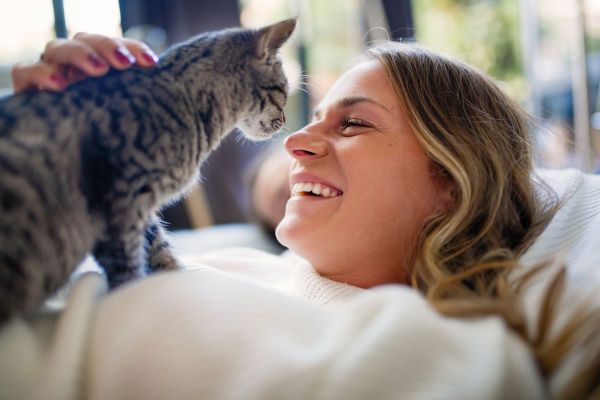What Causes Cats to Vomit?
There are several potential causes for cats vomiting:
- Hairballs – Cats groom themselves regularly and swallow loose hair. Over time, the hair can form into balls that are too large to pass through the digestive tract, causing vomiting as the cat’s body tries to expel them.
- Eating too fast – When cats eat food too quickly, they may swallow air and overfill their stomachs. This can lead to vomiting soon after eating.
- Illness/disease – Conditions like pancreatitis, inflammatory bowel disease, liver or kidney disease can cause nausea and vomiting in cats. Infections and viruses can also be culprits.
- Motion sickness – Some cats become nauseous and vomit when traveling by car.
- Allergies – Allergies to food ingredients can prompt vomiting or nausea in cats.
- Parasites – Intestinal parasites like roundworms can irritate the stomach and intestines, leading to vomiting.
- Foreign objects – Cats may ingest objects like string, plastic, or small toys that can cause a blockage and vomiting.
- Stress – Stress from changes in environment, travel, or introducing new pets can also cause vomiting in cats.

According to veterinarians, some of the most common causes of feline vomiting include hairballs, eating too quickly, and illnesses like pancreatitis [1]. However, there are many potential reasons cats vomit, so it’s important to monitor symptoms and see a vet if vomiting persists.
Why Does Cat Vomit Smell Bad?
There are a few reasons why cat vomit tends to have a particularly foul odor:
Partially Digested Food Smells – When a cat throws up shortly after eating, the vomit will contain partially digested food. This not fully broken down food releases an unpleasant stench. The acidic cat stomach digestive juices can also create noxious smells when mixed with food.
Bile Has a Strong Odor – Bile is a digestive fluid produced in the liver and stored in the gallbladder. It has a very bitter, potent smell. If a cat is throwing up bile or bile-stained vomit, the smell will be especially pungent.
Bacteria Growth in Vomit – Once vomit has sat out for awhile, bacteria will start to grow and decompose it. This leads to a putrid, rotten stench coming from the cat throw up. The longer the vomit sits before being cleaned up, the worse the odor will become.
Tips to Reduce Cat Vomiting
There are some steps cat owners can take to help reduce instances of cat vomiting:
Brush your cat regularly to reduce hairball buildup. Hairballs are a common cause of vomiting in cats. Regular brushing helps remove loose hair that might otherwise end up in the stomach and intestinal tract. Use a cat brush designed specifically for removing loose hair and distribute natural oils over your cat’s coat (WebMD).
Feed smaller, more frequent meals. Eating too much food too quickly can trigger vomiting. Break up your cat’s daily food intake into smaller, more frequent meals to ease digestive upset. This can be especially helpful for cats prone to vomiting after eating.(Newtown Veterinary Hospital)
Use a slow feed bowl. These bowls have inserts that force your cat to eat more slowly and prevent them from gobbling down food too quickly. Slowing the pace of eating can aid digestion.
Give hairball remedy treats. These treats contain ingredients like petroleum jelly to help lubricate the digestive tract and allow hairballs to pass more easily.
Clean the litter box frequently. A dirty litter box can deter your cat from using it, leading to vomiting from constipation or blockages.
When to See the Vet
It’s normal for cats to occasionally vomit, but frequent or severe vomiting episodes may indicate an underlying health issue that requires veterinary attention. Here are some signs that warrant a trip to the vet:
- Frequent vomiting – Repeated vomiting episodes in a short timeframe, such as more than 2-3 times in one day or several days in a row, could signal a problem.
- Vomiting for more than 24 hours – Persistent vomiting that lasts over a day without stopping points to a potentially serious issue.
- Vomiting and diarrhea – Simultaneous vomiting and diarrhea can lead to dehydration and electrolyte imbalances.
- Weight loss – Repeated vomiting paired with weight loss may indicate your cat is not properly absorbing nutrients.
- Loss of appetite – If your cat stops eating due to nausea, this can quickly become dangerous.
- Lethargy – Lethargy and vomiting is a problematic combination, as your cat may be becoming dehydrated or lacking nutrients.
According to vets, if your cat shows any of these symptoms along with vomiting, it’s important to schedule a veterinary visit as soon as possible (1). The vet will run tests to determine the cause and recommend appropriate treatment options to get your cat back to full health.

Tests Vets May Run
If your cat is vomiting frequently or showing other concerning symptoms along with vomiting, the vet may run some tests to try to determine the underlying cause. Here are some of the main diagnostic tests the vet may perform:
Bloodwork: The vet may draw blood to check for signs of infection, kidney issues, liver problems, pancreatitis, diabetes and more. According to VCA Hospitals, bloodwork is often one of the first tests vets will run when a cat is vomiting frequently (https://vcahospitals.com/know-your-pet/vomiting-in-cats).
Fecal exam: The vet may analyze a stool sample to check for intestinal parasites like roundworms, hookworms or protozoa which can cause gastrointestinal issues. According to DVM360, vets often recommend a fecal exam when vomiting is accompanied by diarrhea (https://www.dvm360.com/view/diagnostic-strategy-vomiting-dogs-and-cats-proceedings).
X-rays: Abdominal X-rays allow the vet to visualize the digestive tract and spot potential blockages, tumors, foreign objects, gas buildup or other issues that could be causing vomiting. X-rays can also check for problems with the lungs and heart.
Ultrasound: An abdominal ultrasound uses sound waves to create images of the stomach, intestines, liver, kidneys and other internal organs. It can help identify tumors, stones, abscesses, thickened intestinal walls and more.
Endoscopy: This procedure uses a small camera on a flexible tube to directly visualize the esophagus, stomach and upper intestines. It helps vets locate ulcers, inflammation, foreign objects, tumors and other issues that may not show up on X-rays or ultrasound.
Treatments for Vomiting
Vets may prescribe several treatments for a cat vomiting, depending on the underlying cause:
– Anti-nausea medication like Cerenia can help reduce vomiting by calming the stomach and reducing nausea (https://vcahospitals.com/know-your-pet/vomiting-in-cats).
– Antibiotics may be prescribed if a bacterial infection is causing the vomiting.
– Switching to a bland, easy-to-digest diet like boiled chicken and rice for a few days can allow the stomach to rest and recover (https://www.affordablepetvetclinic.com/site/blog/2022/05/15/cat-vomiting).
– IV fluids can help replenish lost fluids and electrolytes from excessive vomiting and diarrhea.
– If an obstruction or foreign object is causing vomiting, surgery may be required to remove it and allow normal digestion.
Cleaning Up Vomit
Cleaning up after a cat vomiting episode can be unpleasant, but it’s important to thoroughly clean the mess to avoid stains and lingering odors. Start by removing as much of the vomit as possible with paper towels or a spoon. Try to avoid smearing it around. For carpet, blot the area with paper towels to absorb as much liquid as you can.
Next, rinse the area with cold water mixed with a small amount of white vinegar or enzyme cleaner. The vinegar helps neutralize odors. Blot the area again with clean paper towels. On carpet, avoid vigorous scrubbing which can damage the fibers.

For set-in stains, use a pet stain removal product designed for vomit and urine. Check the label and avoid products with ammonia, which can encourage cats to re-mark the area. Let the cleaner sit for 5-10 minutes before blotting it up. Allow the area to fully dry before letting your cat back on the surface.
On tiles, wood, or vinyl, a mix of warm water and dish soap can help lift the stain. Rinse thoroughly afterwards.
For more tips, see this helpful guide on cleaning up after cat vomiting episodes: https://www.aspcapetinsurance.com/resources/cat-vomiting-causes-and-clean-up-tips/
Preventing Future Episodes
There are some steps cat owners can take to help prevent future vomiting episodes:
Feed smaller, more frequent meals – Feeding smaller portions more often can help prevent your cat from gorging and overeating, which can lead to vomiting. Breaking up their daily food into 3-4 smaller meals is ideal.
Slow down eating – Eating too quickly can cause vomiting, so use puzzle feeders or ball feeders to make your cat slow down and work for their food. This prevents them from scarfing down meals.
Treat hairballs – Regular brushing and hairball remedy supplements or treats can help cats pass hairballs more easily, preventing buildup that leads to vomiting.
Identify and remove allergens – Food allergies are common causes of vomiting. Work with your vet to identify problem ingredients and transition to a hypoallergenic diet if needed. Also remove environmental allergens when possible.
When to Worry
Vomiting is usually not a major cause for concern in cats. However, there are certain situations where you will need to take your cat to the vet promptly.
According to the experts at Cornell Feline Health Center (source), you should contact your vet if vomiting persists for over 48 hours. Vomiting that continues frequently and does not resolve on its own can lead to dehydration and electrolyte imbalances. It may also be a sign of a serious underlying health issue.
You should also contact your vet immediately if you notice any blood in your cat’s vomit. Bloody vomit could indicate a gastrointestinal ulcer or inflammation and needs to be addressed right away.
Significant weight loss, lethargy, or loss of appetite when accompanied by vomiting are also red flags according to VCA Hospitals (source). These signs together often mean something more serious is going on, like kidney disease, cancer, or another condition requiring diagnosis and treatment.
In short, while occasional vomiting is normal, any persisting vomiting, bloody vomit, or vomiting along with other concerning symptoms warrants a prompt vet visit for your cat’s health.
FAQs

Is vomiting normal for cats?
It’s common for cats to vomit occasionally. According to the Cornell Feline Health Center, vomiting is a normal protective mechanism that helps cats expel irritants from their digestive system [1]. Vomiting every now and then doesn’t necessarily indicate an underlying health issue. However, frequent vomiting or other concerning symptoms along with vomiting warrant a vet visit.
How often do cats vomit?
There’s no set number for how often cat vomiting is normal. The frequency that is concerning depends on the individual cat, as some cats have more sensitive stomachs. The key is to monitor patterns and look for any changes. Generally, vomiting more than a couple times per week or daily vomiting is excessive and points to an underlying problem that should be addressed by a vet.
What does it mean if cat vomit smells sour?
A sour or rancid smell from cat vomit often indicates the presence of bile, especially if the color is yellow or greenish. Bile is produced in the liver, stored in the gallbladder, and released into the small intestine to help digest fat. When a cat vomits up bile, it means bile is abnormally entering the stomach. This can signal an obstruction, inflammation, or other issue causing bile to back up [2].
Can I give my cat Pepto for vomiting?
It’s best to avoid giving human medications like Pepto-Bismol to cats without consulting a vet first. Pepto contains salicylates that can be toxic to cats at high doses. A vet may recommend an over-the-counter cat upset stomach medication or prescribe something to treat the cause of the vomiting.
[1] https://www.vet.cornell.edu/departments-centers-and-institutes/cornell-feline-health-center/health-information/feline-health-topics/vomiting
[2] https://www.thecatdoctoratlanta.com/learning-center/symptoms/cat-vomit-two-cat-vets-answer-all-of-your-questions

